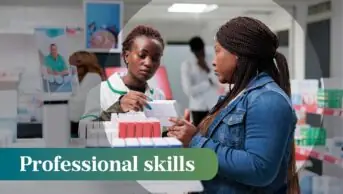
Shutterstock.com / MAG
After reading this article, you should be able to:
- Explain the concept of reflective practice and its importance to pharmacy;
- Describe the five factors that make up a reflective practice model;
- Choose reflective practice strategies to use in your professional life.
Have you ever supervised a student’s work experience or attended a continuing professional development (CPD) event? Now, consider the requirements for renewing your registration with the General Pharmaceutical Council (GPhC). All three of these experiences have a common thread: reflection.
The term ‘reflection’ is used widely. Reflection has been defined as a specific thinking process of “engaging the self in attentive, critical, exploratory and iterative interactions with one’s thoughts and actions, and their underlying conceptual frame, with a view to changing them and with a view on the change itself”[1]. It is an integral requirement of all pharmacy courses, from undergraduate to postgraduate level, including CPD training and post-registration qualifications, such as independent prescribing. The GPhC has always used the concept of reflection in its CPD expectations and, in recent years, it has become an integral part of the revalidation framework. There is a new focus on reflection, impact and on different styles of reflection involving peers.
Why we practise reflection
Advancements in practice — for example the provision of services such as lifestyle counselling, weight loss management, smoking cessation and the management of common ailments — increasingly place pharmacy at the centre of public health initiatives. Expedited by the COVID-19 pandemic, pharmacists are an invaluable resource in the multidisciplinary team. Independent pharmacist prescribers are making their mark in the healthcare landscape, managing acute and chronic conditions in primary care settings, such as community pharmacies and general practice[2].
Based on this expansion of trust, pharmacists have a duty to continually develop their skills and knowledge[3]. Reflective practice gives practitioners a way to identify their strengths and weaknesses, which may help to improve future practice[4,5]. Reflective practice can encourage stimulating thought processes and empower practitioners to achieve best practice[6].
Consistent reflection has been shown to improve decision-making and the provision of care[7]. Debriefing sessions have been used as a platform to facilitate discussion among healthcare professionals, mainly nurses and physicians, to encourage deep thinking and decision-making[6–10]. One study published in 2008 analysed medical residents using reflective prompts and evaluated their potential influence on clinical judgement for accurate diagnosis, against a control group of medical residents who were not exposed to the reflective prompts[7]. The researchers found that reflection using these prompts was a useful tool for practitioners, particularly when diagnosing rare or complex cases. Accurate diagnoses were more likely and there was a reduction in inaccurate diagnoses[7].
Other studies have also recognised the value of physicians maintaining a reflective portfolio as a lifelong learning tool in practice[11]. In 2012, a randomised controlled trial exposed a group of interns to routine direct observation with formal feedback sessions for their first six weeks[12]. Interns in the intervention group displayed better patient care skills compared with the control group, supporting the argument that situation-specific external assessment (such as these formal feedback sessions) is crucial for safe practice[12–14].
A five-factor model of reflection
A systematic review of the literature on reflection identified various actions, beliefs and attitudes that made up a five-factor model[1]. These included themes of the practitioner being attentive, critical and exploratory, in addition to employing iterative thinking and views on change. What practical lessons can be taken from this five-factor model?
1. Be attentive
Being attentive means the pharmacist should treat the patient as a ‘whole’ person, not as a merely as a number with a particular ailment for which medicine is being prescribed and delivered at one point in care. Instead, the pharmacist should be attentive to a patient’s health literacy, confounding factors affecting treatment, their entire health and family history, and their need to recover and resume their daily life activities. This attentiveness helps to ensure the best possible outcomes for patients from their medication, often in the presence of real-world situations where the patient may not be adherent to treatment or might encounter barriers to recovery.
2. Be critical
Being critical means the pharmacist should think critically about the interactions they had when providing care and find ways they could have provided this care more effectively. For example, could they have employed motivational interviewing, or asked more open-ended questions that would have led to a more successful interaction with the patient? Could they have acquired more information from a physician or other health practitioner, which would have helped to optimise care? Could they have better ensured that the patient left the pharmacy equipped with the relevant information required to optimise their medicines?
3. Be exploratory
Being exploratory refers to pharmacists considering new strategies, services and novel models of care that could improve on the status quo. This requires the pharmacist to be reflective about their day-to-day practice and reading the current literature in the area of pharmacy practice they are reflecting on to improve care delivery.
4. Employ iterative thinking
Employing iterative thinking means pharmacists should regularly contemplate their provision of care and interactions with patients and take incremental steps to improve this process, continuing to do so in a way that brings them closer to their goal of providing optimal care.
5. Have views on change
Finally, to have views on change means that pharmacists must recognise the constant state of ‘flux’ of healthcare practice, which is constantly evolving and shifting. The complexities of practice include the evolving needs of patients, the shifting demographics of patients, the rapid evolution of technology and other factors that impact care. This can be positive change if taken into account and leveraged effectively, but negative if ignored by the pharmacist. For example, community pharmacists engaging in social media to explain the range of available services to the public can be a powerful tool to support public health and counter misinformation.
As such, reflective practice involves critical thinking with self-evaluation and practice that enables continuous improvement, development and, ultimately, better future practice[15–17]. Pharmacy can learn from other professions and the seminal models and literatures that have helped inform practice: for example, Gibbs, Schon, Atkins and Murphy, Kolb, Johns, and Mezirow’s models[4,18–23]. Individual pharmacists can then tailor their approach for reflection during and after action, based on the reflective process already described in this section.
Ways to overcome difficulties when engaging in reflective practice
Reflection in action (i.e. during an ongoing situation) can be challenging for practitioners because it is a complex concept requiring continued input from deep thought processes and from reliable external sources. In settings such as community pharmacy, these external sources may be lacking. For example, when a pharmacist completes a ward round, they have a multidisciplinary team available on request to share ideas and contribute to the patient’s care; a community pharmacist is often isolated when checking a prescription and lacks this valuable resource.
Diverse educational strategies can be used to teach healthcare practitioners about reflection, such as portfolios, creative writing workshops, self-report questionnaires, reflective vignettes and learning logs[24–27]. A review concluded that, since the purpose of reflection is to improve judgement, personally develop and contextualise practice, each reflective task needs to be clearly articulated to learners[15]. Additionally, leaders in practice need to model effective reflective strategies for other staff at each practical opportunity.
One such strategy is for senior colleagues to use ‘thinking aloud’ techniques. This allows less senior staff to understand that making a decision is not as easy as it might appear and that everyone needs to consider their options, what information they have available, and the associated risks. Senior staff often do this so fast that it can seem to observers that no in-action reflection is taking place. For example, an experienced pharmacist checking a medication administration chart in a short amount of time may seem from the outside that there is nothing to consider. If experienced pharmacists could occasionally vocalise their thoughts and show the tremendous amount of reflection that goes on all the time, it can be of enormous benefit for their more junior colleagues.
Finally, reflective practice is most effective when assessed properly. A person engaged in reflective practice should not only reflect on the quality of their own reflection but also seek the guidance and mentoring of others. This is the concept of ‘peer review’ that the GPhC has introduced in their updated revalidation requirements[28].
Reflective practice in healthcare education
The use of reflection to prepare for the complexities of clinical practice is gaining traction in pharmacy education literature. One study employed Kolb’s learning style framework to ascertain pharmacy students’ learning styles[29]:
- Assimilator — logical and structured learner, prefers didactic approach, input from experts in the field and learning independently;
- Diverger — open-minded learner, prefers to work in groups and learning with brainstorming sessions;
- Converger — relatively unemotional learner, prefers to work independently and learning with technical tasks;
- Accommodator — prefers to work in teams and learning with a ‘risk-taking’ approach, through gut feeling and actively engaging with situations.
Students who were classified as ‘assimilators’ and ‘divergers’ were more likely to use reflective processes and observation[30]. A later study adapted Mezirow’s reflection model to explore the relationship of reflective writing skills and academic success among undergraduate pharmacy students[30]. There were significant links between the two, indicating the importance of reflection in achieving goals[30].
In another study, students in experiential placements were provided with a stakeholder-informed, structured but flexible reflective template that they could use across their placements, regardless of type or duration[31]. Use of the template was found to increase critical thinking[31]. Strategies that involve social media have also been effective in supporting pharmacy students to reflect[32,33].
Reflective practice and prescribing
In situations when pharmacists engage in prescribing practices, therapeutic decision-making is of paramount importance. Eight steps have been identified as being involved in pharmacists’ current therapeutic decision-making[34]:
- Use documented information about a patient;
- Use communication skills to elicit information from a patient;
- Recognise past experiences with patients and apply these to the current patient;
- Refer to guidelines or protocols while being aware of their limitations;
- Generate a list of viable options suitable to meet goals;
- Weigh up the benefits and risks of the options;
- Learn to accept uncertainty;
- Involve other healthcare professionals and the patient in the decision.
The study authors recommended that educators encourage deeper, more holistic reflection on the patient, in addition to reflection on their professional identity as clinicians and prescribers, to improve decision-making[34].
It has been suggested that clinical decision-making remains a critical, missing ingredient that would enable pharmacists to expand their scope beyond merely the dispensing of medicines[35]. An alternative model of clinical judgment would be centred around the patient rather than the prescription[35]. Pharmacists can be overly risk averse and can lack confidence when dealing with ambiguous situations[35]. Basic and continued education and revalidation models should encourage the type of deep thought and reflection that prepare pharmacists to deal with ambiguity and assume further responsibility.
Conclusion
Reflective practice is a learned skill that can be developed through guided instruction and programmes already available within and outside of pharmacy. While revalidation now includes an element of reflection, pharmacists can take it upon themselves to identify their strengths, further connect with the profession and their identity, and determine their own preferred learning styles to leverage their new reflective practices.
- 1Nguyen QD, Fernandez N, Karsenti T, et al. What is reflection? A conceptual analysis of major definitions and a proposal of a five-component model. Med Educ. 2014;48:1176–89. doi:10.1111/medu.12583
- 2Collins S. A tale of two countries: The path to pharmacist prescribing in the United Kingdom and Canada. Pharmacy Today. 2014;20:6–8. doi:10.1016/s1042-0991(15)30943-9
- 3Walpola R, Lucas C. Reflective practice: the essential competency for health systems and healthcare practitioners during the COVID-19 pandemic. Reflective Practice. 2020;22:143–6. doi:10.1080/14623943.2020.1860925
- 4Schon D. The Reflective Practitioner: How Professionals Think In Action. 1st ed. New York: : Basic Books 1984.
- 5Thompson N, Pascal J. Developing critically reflective practice. Reflective Practice. 2012;13:311–25. doi:10.1080/14623943.2012.657795
- 6Gustafsson C, Fagerberg I. Reflection, the way to professional development? J Clin Nurs. 2004;13:271–80. doi:10.1046/j.1365-2702.2003.00880.x
- 7Mamede S, Schmidt HG, Penaforte JC. Effects of reflective practice on the accuracy of medical diagnoses. Med Educ. 2008;42:468–75. doi:10.1111/j.1365-2923.2008.03030.x
- 8Kim YH, Min J, Kim SH, et al. Effects of a work-based critical reflection program for novice nurses. BMC Med Educ. 2018;18. doi:10.1186/s12909-018-1135-0
- 9Lutz G, Roling G, Berger B, et al. Reflective practice and its role in facilitating creative responses to dilemmas within clinical communication – a qualitative analysis. BMC Med Educ. 2016;16. doi:10.1186/s12909-016-0823-x
- 10sedgwick monique, Grigg L, Dersch S. Deepening the quality of clinical reasoning and decision-making in rural hospital nursing practice. RRH. 2014. doi:10.22605/rrh2858
- 11Koshy K, Limb C, Gundogan B, et al. Reflective practice in health care and how to reflect effectively. IJS Oncology. 2017;2:20. doi:10.1097/ij9.0000000000000020
- 12Shelesky G, D’Amico F, Marfatia R, et al. Does weekly direct observation and formal feedback improve intern patient care skills development? A randomized controlled trial. Fam Med 2012;44:486–92.https://www.ncbi.nlm.nih.gov/pubmed/22791533
- 13Eva KW, Regehr G. Self-Assessment in the Health Professions: A Reformulation and Research Agenda. Academic Medicine. 2005;80:S46–54. doi:10.1097/00001888-200510001-00015
- 14Mantzourani E, Desselle S, Le J, et al. The role of reflective practice in healthcare professions: Next steps for pharmacy education and practice. Research in Social and Administrative Pharmacy. 2019;15:1476–9. doi:10.1016/j.sapharm.2019.03.011
- 15Tsingos C, Bosnic-Anticevich S, Smith L. Reflective Practice and Its Implications for Pharmacy Education. AJPE. 2014;78:18. doi:10.5688/ajpe78118
- 16Le J, Mantzourani E, Desselle S, et al. Enhancing future pharmacy practice through integration of reflective practice strategies to embed self-development in a medication safety culture. Research in Social and Administrative Pharmacy. 2019;15:e18. doi:10.1016/j.sapharm.2019.03.119
- 17Mann K, Gordon J, MacLeod A. Reflection and reflective practice in health professions education: a systematic review. Adv in Health Sci Educ. 2007;14:595–621. doi:10.1007/s10459-007-9090-2
- 18Lucas C, Power T, Kennedy DS, et al. Conceptualisation and development of the RIPE-N model (reflective interprofessional education-network model) to enhance interprofessional collaboration across multiple health professions. Reflective Practice. 2020;21:712–30. doi:10.1080/14623943.2020.1784866
- 19Gibbs G. Learning by Doing: a guide to teaching and learning methods. Oxford: : Further Education Unit. Oxford Polytechnic 1988.
- 20Atkins S. Reflective practice. Nursing Standard. 1994;8:48–56. doi:10.7748/ns.8.39.48.s64
- 21Kolb DA. Experiential Learning: Experience As The Source Of Learning And Development. Prentice-Hall 1984.
- 22Johns C. Framing learning through reflection within Carper’s fundamental ways of knowing in nursing. Journal of Advanced Nursing. 1995;22:226–34. doi:10.1046/j.1365-2648.1995.22020226.x
- 23Mezirow J. Fostering Critical Reflection: A Guide to Transformative and Emancipatory Learning. Jossey-Bass 1990.
- 24Mamede S, van Gog T, Moura AS, et al. Reflection as a strategy to foster medical students’ acquisition of diagnostic competence. Medical Education. 2012;46:464–72. doi:10.1111/j.1365-2923.2012.04217.x
- 25Gull SE. Creative writing workshops for medical education: learning from a pilot study with hospital staff. Medical Humanities. 2002;28:102–4. doi:10.1136/mh.28.2.102
- 26Baernstein A, Fryer-Edwards K. Promoting Reflection on Professionalism. Academic Medicine. 2003;78:742–7. doi:10.1097/00001888-200307000-00018
- 27Boenink AD, Oderwald AK, de Jonge P, et al. Assessing student reflection in medical practice. The development of an observer-rated instrument: reliability, validity and initial experiences. Med Educ. 2004;38:368–77. doi:10.1046/j.1365-2923.2004.01787.x
- 28Revalidation framework . General Pharmaceutical Council. 2018.https://www.pharmacyregulation.org/sites/default/files/document/gphc_revalidation_framework_january_2018.pdf (accessed Sep 2022).
- 29Tsingos C, Bosnia-Anticevich S, Smith L. Does a learning style preference for processing information through reflection impact on the academic performance of a cohort of undergraduate pharmacy students? Pharmacy Education, 15 Published Online First: September 2015.https://pharmacyeducation.fip.org/pharmacyeducation/article/view/392
- 30Tsingos-Lucas C, Bosnic-Anticevich S, Schneider CR, et al. Using Reflective Writing as a Predictor of Academic Success in Different Assessment Formats. AJPE. 2017;81:8. doi:10.5688/ajpe8118
- 31Deslandes R, Lucas C, Hughes ML, et al. Development of a template to facilitate reflection among student pharmacists. Research in Social and Administrative Pharmacy. 2018;14:1058–63. doi:10.1016/j.sapharm.2017.11.010
- 32Desselle SP. The use of Twitter to facilitate engagement and reflection in a constructionist learning environment. Currents in Pharmacy Teaching and Learning. 2017;9:185–94. doi:10.1016/j.cptl.2016.11.016
- 33Benetoli A, Chen TF, Aslani P. The use of social media in pharmacy practice and education. Research in Social and Administrative Pharmacy. 2015;11:1–46. doi:10.1016/j.sapharm.2014.04.002
- 34Anakin MG, Duffull SB, Wright DFB. Therapeutic decision-making in primary care pharmacy practice. Research in Social and Administrative Pharmacy. 2021;17:326–31. doi:10.1016/j.sapharm.2020.04.005
- 35Wright DFB, Anakin MG, Duffull SB. Clinical decision-making: An essential skill for 21st century pharmacy practice. Research in Social and Administrative Pharmacy. 2019;15:600–6. doi:10.1016/j.sapharm.2018.08.001


